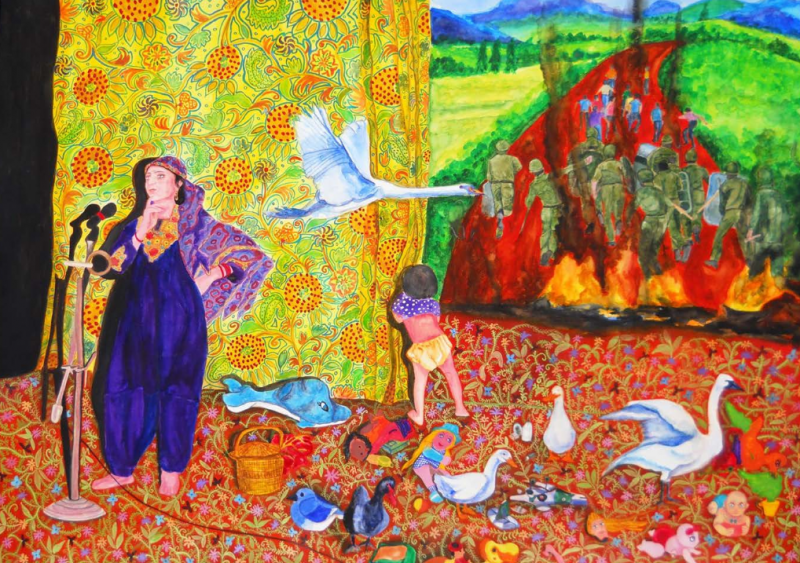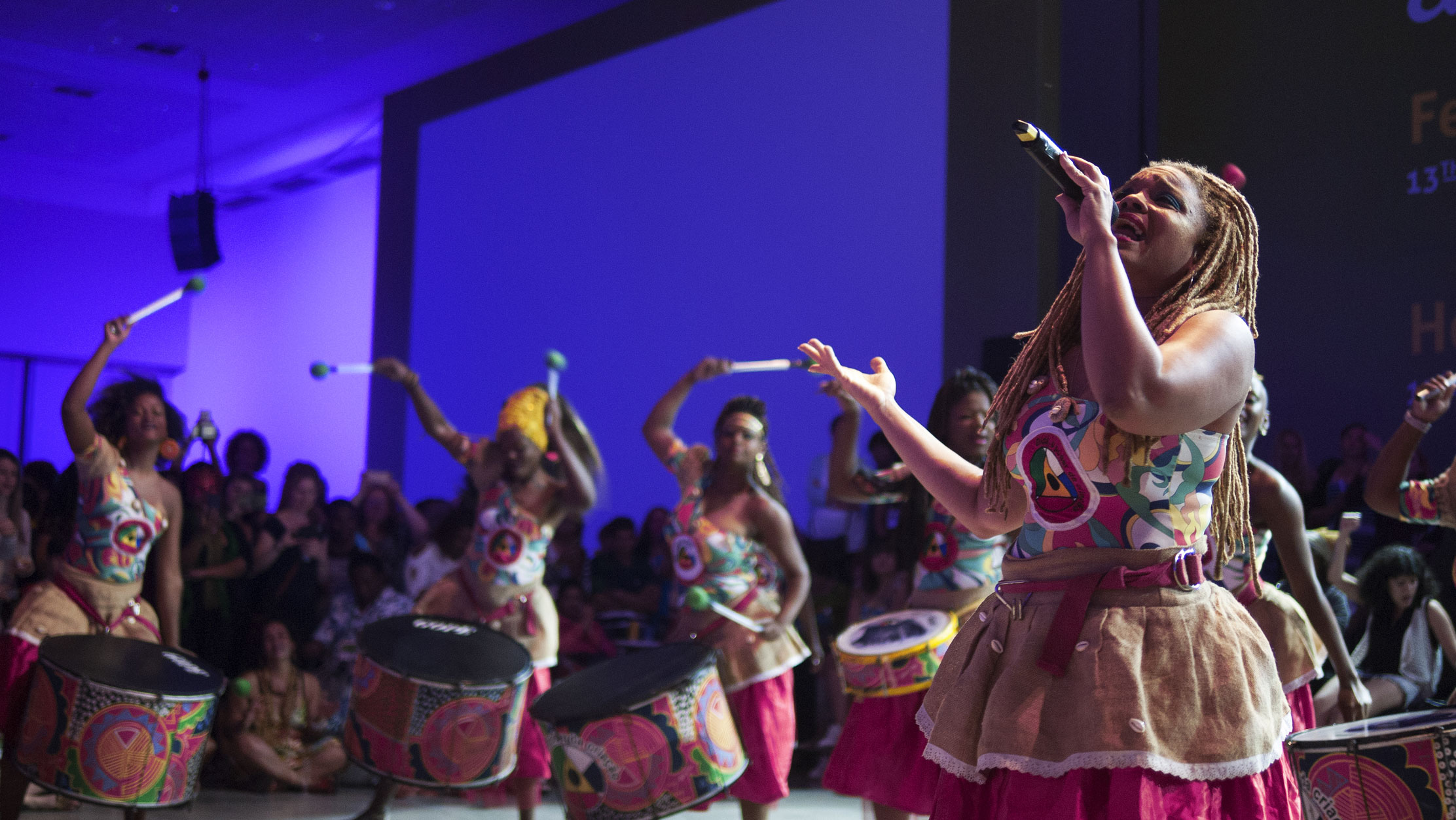In 2016, the Indian-occupied state of Kashmir once again erupted in valley-wide protests, in collective expression for freedom, after the killing of a popular militant leader Burhan Wani. The protests continued for over six months and resulted in the killing of around 100 civilians.
Some of the most overpowering moments during that period were of women-led protests. February 23rd is Kashmiri Women’s Resistance Day. In this reflection, writer and activist Essar Batool reflects on Kashmiri women’s struggle for freedom.
I am a woman, living in Indian-occupied Kashmir, a place that has been at the heart of a violent conflict for decades.
India has responded to Kashmiris’ longstanding demands for self-determination by deploying 700,000 Indian armed forces personnel to crush the desire for freedom, and as it says, to crush the armed rebellion which currently stands at a rough 150 armed fighters. In this duration of time, India has been responsible for countless war crimes in Kashmir which include extra-judicial custodial killings, enforced disappearances, mass graves, and sexual violence of the worst kind.
Women have been at the receiving end of this occupation as direct and indirect victims of violence by the State. Women have lost their loved ones; husbands, brothers and sons, some of whom were killed and some never returned. This gave rise to a new sub-category among women, called ‘half-widows’, women living in the hope of knowing whether their husbands are alive or dead. Moreover, rapes have been used by the Indian armed forces against Kashmiri women, and the figures are alarming; even though these cases have been documented by international investigating agencies such as Human Rights Watch and Physicians for Human Rights, the majority of such cases continue to remain unreported.

The reluctance to report a case stems from the fear of reprisal by the Indian armed forces and also from the fact that not even one member of the Indian armed forces has been prosecuted to date in any case of human rights violation. Even when court martials happen, in rare cases, the punishments are disciplinary, not punitive, as in case of Major Rahman in 2004, where he raped two women of a family but was suspended from service and later acquitted. In such a scenario where there is no accountability of an occupying state and worse, it has legal, moral and political impunity to protect its armed forces, the discourse about sexual violence, against both women and men is obviously bound to be lost.
In Kashmir, sexual violence has been used as a tool, against both women and men to break resilience at the community and individual levels.
In the case of men, it is mostly to break their morale and extract information and in the case of women it is mostly to force a community into submission, using the existing patriarchal structure that places the burden of honour on women. The Jammu Kashmir Coalition of Civil Society has documented 7,000 cases of sexual violence that also include sexualized violence against men in custody, mostly sodomy. We know the numbers are far less than what the actual situation is; shame, stigma and reprisals do not allow for a conducive atmosphere in which to report sexualized violence.

During times of crisis and long, extended protests, cases have been reported of pregnant and unwell women who were not allowed to reach hospitals, because of the curfew put in place by the state. The military occupation has taken its toll on women in all aspects, whether it is in affecting their rights to basic amenities or the larger right to a life with dignity, free from fear for their safety and fear of violence.
Women have been always a part of the strong political voice that is omnipresent in Kashmir and has made itself known in months-long protests, and resulting in the loss of young lives at the hands of the Indian armed forces, as in 2008 and 2010. In 2016, Kashmir again erupted in valley-wide protests, in collective expression for freedom, after the killing of a popular militant leader Burhan Wani. The protests continued for over six months and resulted in the killing of around 100 civilians, most of whom were young boys in their teens and late twenties. Thousands were injured and hundreds of young people blinded as a result of live bullets and pellets being fired on the protestors. Where often Indian state representatives have used the term ‘misguided youth’ to describe the protestors, the claims were clearly unfounded when people of all ages, genders and religions came out to protest.
However, this action is not new to Kashmiri women, who have been portrayed by the media and writers, as victims who have suffered only through the loss of their men, or resisted only by supporting their men. Women were casualties last year too, both killed and blinded by the Indian armed forces, who fired indiscriminately, the target for them ageless and genderless. There were endless reports of women being beaten and sexually harassed by the government forces, for their participation in pro-freedom marches or as part of the collective punishment for protests led by men.
For Kashmiri women resistance has been present from the start of the movement against the Indian occupation of Kashmir, and has only changed forms, from passive to active roles.

From the beginning Kashmiri women have provided safe refuge to their men and to armed fighters, often acting as couriers, supplying food and providing shelter, saving them from Indian armed forces. They have hidden weapons, whispered important messages and come between death and their loved ones far too often. Women have sung songs, glorified martyrs, and thus preserved memories and people forever to be remembered.
This has come at a cost, a cost that is often too common in a conflict; the bodies of the women have been used by the Indian armed forces to break the community as a whole, by attacking the ‘honour’ that a society attaches to its women. The women of Kunan Poshpora, where soldiers of the 4th Rajputana Rifles mass raped between 30-100 women, for, as the Indian armed forces put it, ‘sympathising and hiding militants and weapons’, are a proof of what the very patriarchal institution that is the military can and will do in a patriarchal society to silence voices rising against it.
Even then, at enormous peril to their safety, women have not shied away from expressing their political voice, which is the same as the rest of the population of Kashmir: Azaadi (Freedom).
Women have braved socio-economic, and health fallouts of the conflict either by losing breadwinners to a bullet, or to the oblivion of a disappearance, to continuously evolve as the strongest pillars of resistance, while simultaneously changing and fitting into gender roles within their societies, moving from dependents to bread earners, from followers to leaders within families. The physical presence of women in pro-freedom marches is not new or unheard of - this happened back in 1990’s when the armed movement was at its peak in Kashmir - but over the years women have been seen more frequently on the roads, expressing themselves, and often with stones in their hands. 2016 was no different and a collective resistance from women was seen on the streets; these gatherings were either spontaneous or in some cases organized and mobilized by pro-freedom women’s groups such as the Dukhtaran e Milat (Daughters of the Nation).
Apart from the thousands of nameless women, fighting pitched battles with armed forces on streets and women fighting the state legally or in political spaces, there are younger women who are challenging narratives, one at a time, breaking the long silence that the Indian state has managed to maintain around Kashmir and its realities. Iffat Fatima, an independent film-maker has made a documentary ‘Khoon diy baarav’ (Blood leaves its trails) that revolves around the question of the whereabouts of thousands of disappeared people in Kashmir. Uzma Falak, a young poet and researcher, uses poetry as a form of expression remembering countless incidents that mark the Indian occupation of Kashmir, as here in a collection of poems focusing on memory and resistance:
“Memory is not a victim but a survivor
like grandmothers, daughters, fathers, brothers
women, men and children of
Kunan and Poshpur, Shopian, Handwor
Dardpur, Kopwor, Uri, Srinagar, Kishtwar...
Memory is a festering wound:
...February 23, February 24, May 30, October 28, November 7...
...1700s, 1800s, 1900s, 2000s...”
When we started the struggle to have the Kunan Poshpora mass rape cases reopened and wrote the book, Do you Remember Kunan Poshpora?, we were part of this new movement that used memory as a method of resistance, pointed out forgetfulness as a weapon used by the state and broke the deafening silence that had been created around Kashmir and Kashmiri women.
Such initiatives, writing and producing counter narratives through art and literature are encouraging more young women to create their spaces in a domain that has been a stronghold of men.
The invasion of women in these spaces means more voices of women being included not as mothers, daughters, and sisters as they have been seen for years but as independent individuals equally or more affected by occupation, with an agency of their own, speaking for themselves, women standing for women, creating an endless solidarity, a forceful shouting of narratives, shattering to pieces the walls of silence that the occupier has built, and resisting in multiple roles, keeping intact the backbone of the resistance movement.
About the author
Essar Batool is a professional social worker from Kashmir and a petitioner in the case against the Indian Armed Forces in the Kunan Poshpora mass rape case of 1991. Batool is also co-author of the book Do you remember Kunan Poshpora? and works on the development of expression and spaces among young women, creating spaces for dialogue based on understanding of gender among youth and volunteers with the Jammu Kashmir Coalition of Civil Society documenting human rights violations in Jammu and Kashmir.
See artwork by Rollie Mukherjee on the Kashmiri resistance (PDF)
